Another COVID-19 school year? How these families survived – and are bracing to do it again
In the middle of her shift working at a New York university dining hall, a single mother scrawls out a math problem on scrap paper as she helps her teenage daughter find the answer over the phone.
Around a family of seven's crowded dining room table, spotty internet freezes five computer screens. The disruption halts five virtual classes and draws groans from the family's five children.
In a tiny apartment with a hole in the ceiling, a 9-year-old girl closes her Chromebook and hugs her grieving mother, a momentary comfort amid the many losses they've experienced.
For the past 18 months, the COVID-19 pandemic has forced families to make choices about their children's education they'd never before faced. Traditional boundaries between living and learning blurred, leaving families to strike a balance between school and household life as it all unspooled around them.
Since school began last fall, six families whose children attend public school in urban districts across New York state have opened their homes to USA TODAY Network journalists to offer an intimate look at the frustrations, worries and realities of learning during a pandemic.
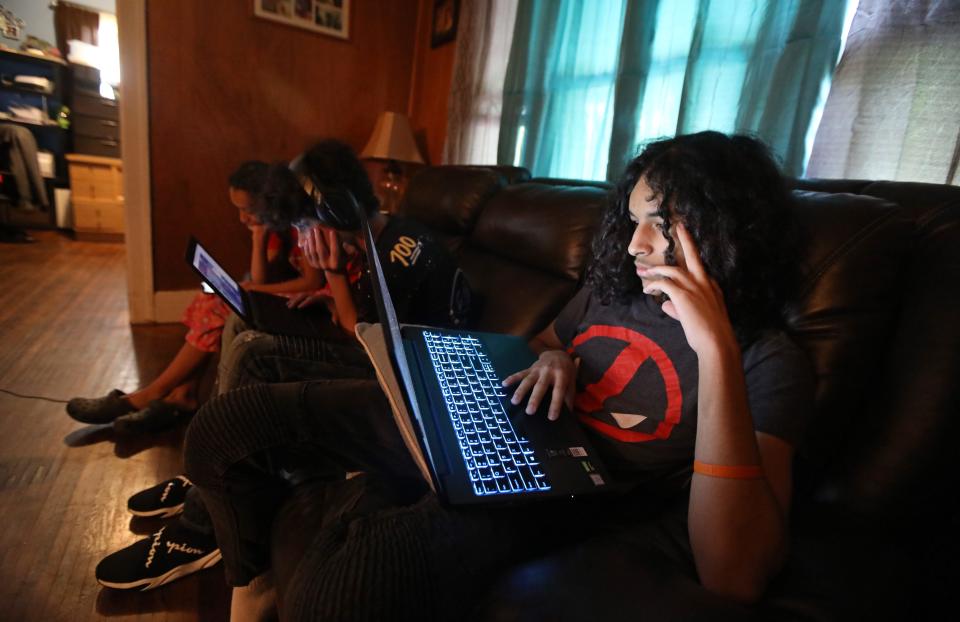
They are big, multi-generational families, small families who rely on each other, immigrant families and blended families. They are families who, when the opportunity arose to send their children back into school buildings, chose instead to keep them home, reflecting a trend in lower-income districts across the country.
And as a new school year begins, these families are reeling from a realization: Despite all of the caution and careful planning that helped get them through last year, they're facing a new round of even more uncertainty because of the delta variant. Like many other families across the country, they're sending their kids back to school in a pandemic landscape that's much more treacherous than it was last fall.
COVID-19 surge: Are schools to blame? Partly, experts explain.
Together, their stories reveal a new school reality shaped by the ups and downs of an education system in flux, while intrinsically linked to a family's particular resources, needs and culture. Their journeys reflect national trends of which students were able to return to school last year, and which families took advantage of the option.
At the heart of it all, a single pillar of strength emerged: the power of the family working together as a unit, whether it’s a team of two or 11.
Which families chose online school
In March 2020, no one knew what pandemic education was going to look like. No one could even fathom the choices parents and students were going to have to make or the many different options for learning.
Most school districts in New York began the first weeks of the 2020 school year 100% remote. The option to begin a hybrid schedule — some days in school, some days remote — would open up later in the fall.
When 800 New York parents were surveyed by The Education Trust New York, which works alongside civil rights, business and other advocacy organizations to advance educational equity, they revealed a nearly 20% gap – by ethnicity, geography and income – on going all remote.
Of those keeping their children home full time in October:
53% were parents of color, 33% were white
54% were low-income households, 37% were high-income
53% were in New York City, 39% upstate, 31% in New York City suburbs
In a later survey, parents would cite lack of safety precautions, perceived vaccination rates among teachers, staff and parents, and the difficult transition to an in-person routine as concerns for going back full time.
“They say school is the safest place," Rochester mother of five Zumarie Sepulveda said in February, "but I don’t think it is.”
How to do school safely: Denver has a strict vaccine mandate for teachers, plus masks. It's working.
Benefits of staying home
Norma Santiago, a night nurse living in Mount Vernon, has excused herself from family dinners, worn a mask inside the house, and rebuffed kisses to keep the coronavirus out of the household.
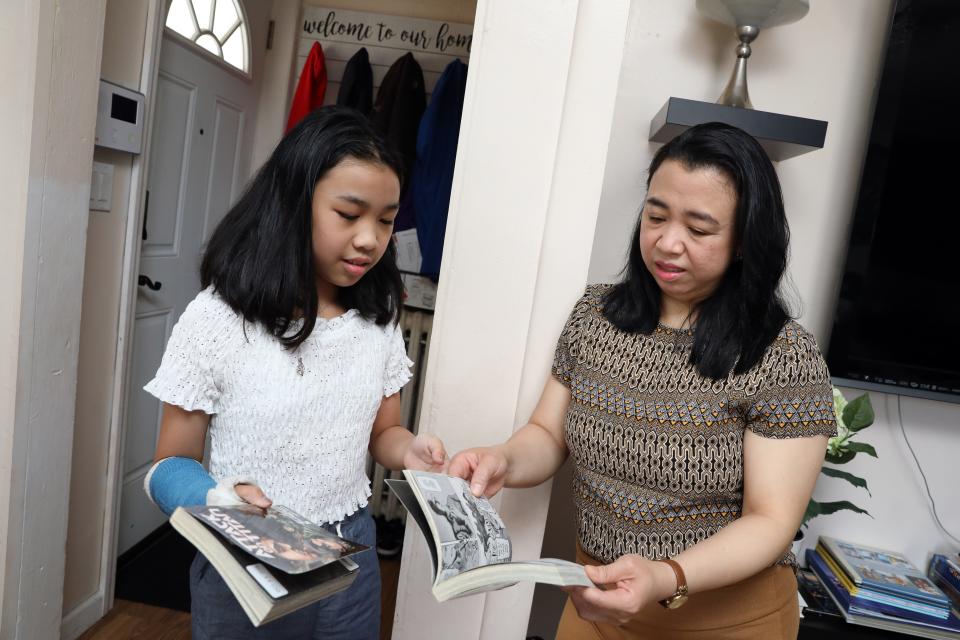
With no close relatives nearby – the family left their home in the Philippines in the early 2000s – and high-schooler Bryan's history of childhood illness, the Santiago family turned inward for strength and safety.
Last year, Santiago's husband, Jose, stayed home with Bryan and his younger sister, Julia, while they learned remotely.
The Santiago family hoped to keep both children home into this new school year until a good share of students and school staff were vaccinated. But in early August, the district said there were no plans to offer a remote option to students. So the Santiagos are heading back to their school buildings.
“I'm excited," Bryan said, "but then there's a lot of changes."
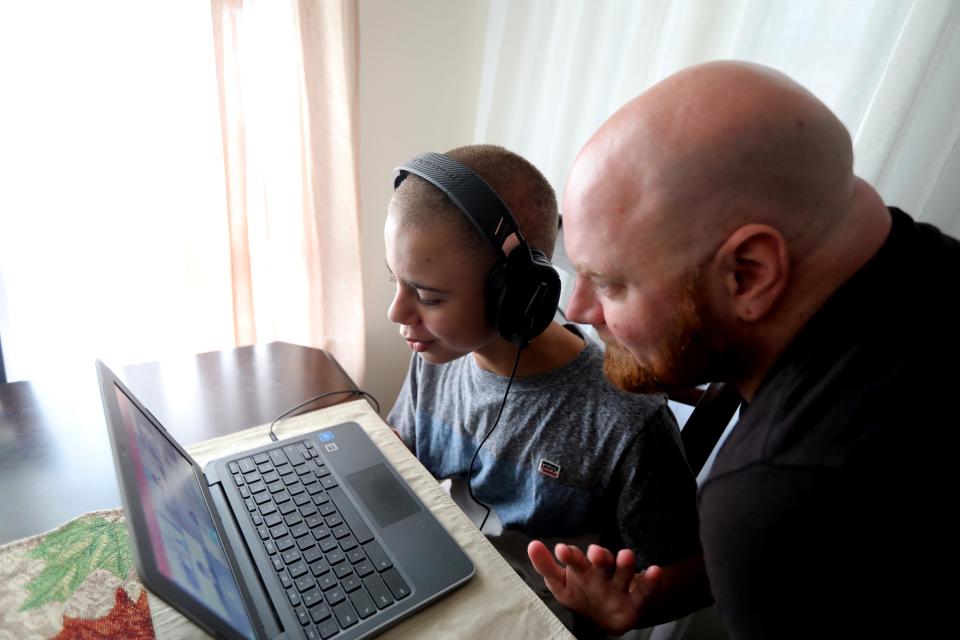

There were other reasons to stay home. In Middletown on a school day in November, middle schooler Jordan Jansen, who has autism, pulled on bulky black headphones, blocking out the noise from the rest of the house. A jump in COVID-19 cases last year gave the Jansen family the option to bring their four school-age children home, and they took it.
While learning remotely, parents Antoinette and Louis believed, they could monitor Jordan more closely if they needed to and could witness his progress by his side. He made the seventh-grade honor roll last year. Antoinette can't help but wonder if being home helped make that success happen.
After a tough year, schools axed virtual learning: Some families want to stay online.
The chaos – and routine – of living, learning together
In a Utica family of 11 Karen refugees originally from Myanmar, high schooler Say Kler Paw took the lead on making sure her younger siblings got their work done, helping cousins and family friends in the community. Like her parents and grandparents, many of their families do not speak English.
Refugees from more than 35 countries have settled in the Utica area since 1979, including more than 4,000 from Myanmar. The Utica schools teach 1,724 English language learners, about half of them Asian, out of a total enrollment of almost 10,000, according to state data. Karen is the most common first language.
Carving out space to work in has been difficult – the three youngest children slept and completed most of their work downstairs while the three older girls worked upstairs in their bedroom – but for this family, keeping up with their education is paramount.
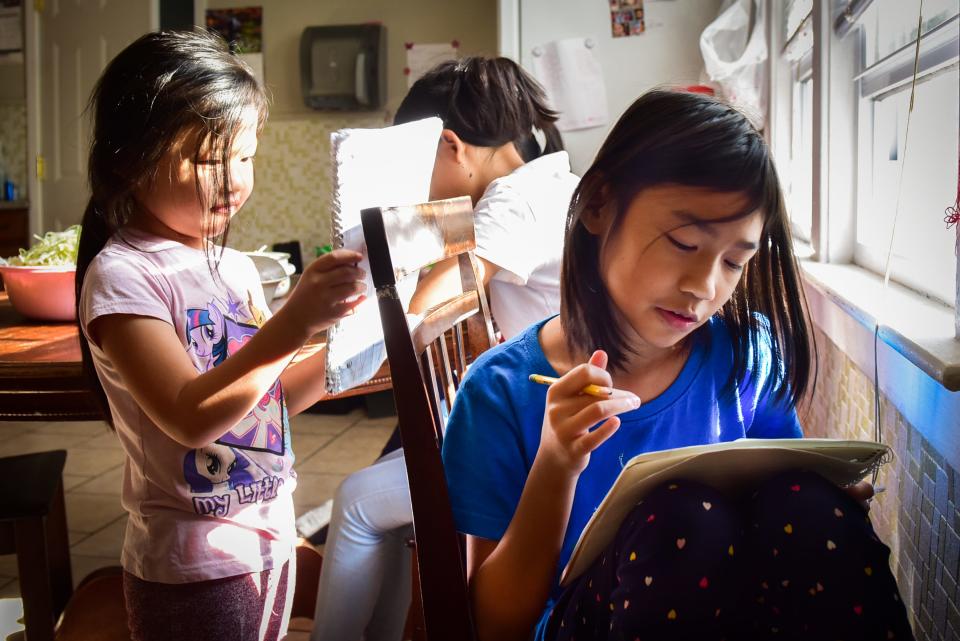
Neither Say Kler Paw's mother, Khee Paw, or father, Tay Heh, received an education beyond lessons written in the bark on trees because their families were displaced by civil war in Myanmar when they were growing up.
Khee Paw is happy and grateful for the education and opportunities her children are receiving now, no matter what that looks like.
The family's four younger children plan to return in person to the Utica schools this fall: Say Kler Paw is a senior; Say Kler Lweh, a sophomore; Saw Kler Kaw Htoo, a sixth grader; and Eh Moo Taw Heh, a fourth grader.
The family is excited about going back to school and hopes in-person learning will prove more productive, Say Kler Paw said. But with COVID-19 cases surging again, all the siblings are taking precautions to protect their grandparents.
“We are worried that it may impact our learning experience this year,” she said, “but we are hoping everything will slowly recover back to normalcy.”
In Binghamton, Davita Bateman's past has also fueled her determination to see her children succeed. A single mother to teenagers CJ and Raelin, Bateman has spent years breaking a toxic cycle that ensnared her life.
In their tiny two-bedroom apartment on a noisy city street, she tried her best to give her children separate spaces to work in last year. But for CJ, true calm only came twice a week, when he took in-person carpentry classes at the local career center.
This school year, despite her concerns about the delta variant, Bateman's teenagers are attending high school in person. Binghamton City School District offers a hybrid option for some students, and the Bateman family’s new, larger apartment in a quiet neighborhood on the city’s South Side would provide a better environment for remote learning than their previous home did.
But students must have a proven attendance record above 70% to qualify, something Bateman’s son, CJ, doesn’t have. He’s fully vaccinated, and Bateman’s daughter, Raelin, was scheduled to receive her first dose of the vaccine before school begins. But the flexibility the Batemans had last year – to begin fully remote, then choose a hybrid model later in the year – is gone.

In Rochester, Zumarie Sepulveda, a mother of five, transformed her dining room table into a computer lab at the beginning of last school year.
She bought headphones for each of her children, set up notebooks and folders, stacked pencils and erasers in wire dividers at the center and pinned colorful behavior charts where her younger kids could see them.
A designated space for learning, she hoped, would help the entire family outline a boundary between school and household life. But one parent was pursuing a bachelor's degree of her own and the other working full time. And with juggling schedules, internet outages and the realities of the daily grind, the hub she'd envisioned fell apart.
The table became just one of many spots throughout the house where her children would try to learn, and when her teenage son, Reinaldo, did better in his in-person summer school classes than he had all year remotely, Zumarie knew being in school would be better for all of them in this new school year.
Still, she's concerned about the delta variant and the number of children who've been infected. She's bought each of her children a bottle of hand sanitizer to keep with them and implored them to keep their distance from other people.
“Listen, this is something that’s serious,” she tells them. “It still hasn’t gotten any better. Just because you’re going to school in person doesn’t mean that you are going back to your normal routine. There’s nothing normal about you going back to school in person. It’s still the same restrictions and the same concerns.”

Life didn’t stop for remote school
In April, the entire Sepulveda family contracted COVID-19. In February, while juggling two jobs – one, her dream job as a family peer advocate, and the other working in one of Binghamton University's dining halls – her teenagers' hybrid learning schedules and her own volunteer work, Davita Bateman suffered a stroke.
In Poughkeepsie, Diamond Yeno began remote elementary school while adjusting to life with her mom, Kendra Smith, who had recently regained full custody of her. She left her previous school district and classmates.
Kendra traced a rocky path to reunion, overcoming incarceration, homelessness, multiple family deaths, addiction, health complications, domestic abuse and a deep depression that led her to attempt suicide twice.
She worked multiple jobs and tried to help Diamond through her school work when she could, but the realities of everyday life upended their routine.
Toward the end of the school year, the pair were dealt a crushing blow: an eviction notice that forced them to relocate to another city. Before this school year began, Diamond reenrolled in her Poughkeepsie school, and Kendra hopes to create a stable environment for Diamond to successfully move on from third grade regardless of their changing living situation.
"Things were calm for a while and she was doing good, but right now if I'm under stress she gets under stress, so it's not good," she said. "We are constantly together, so it's not like I can go and take a breather – she's always there, so she experiences a lot."
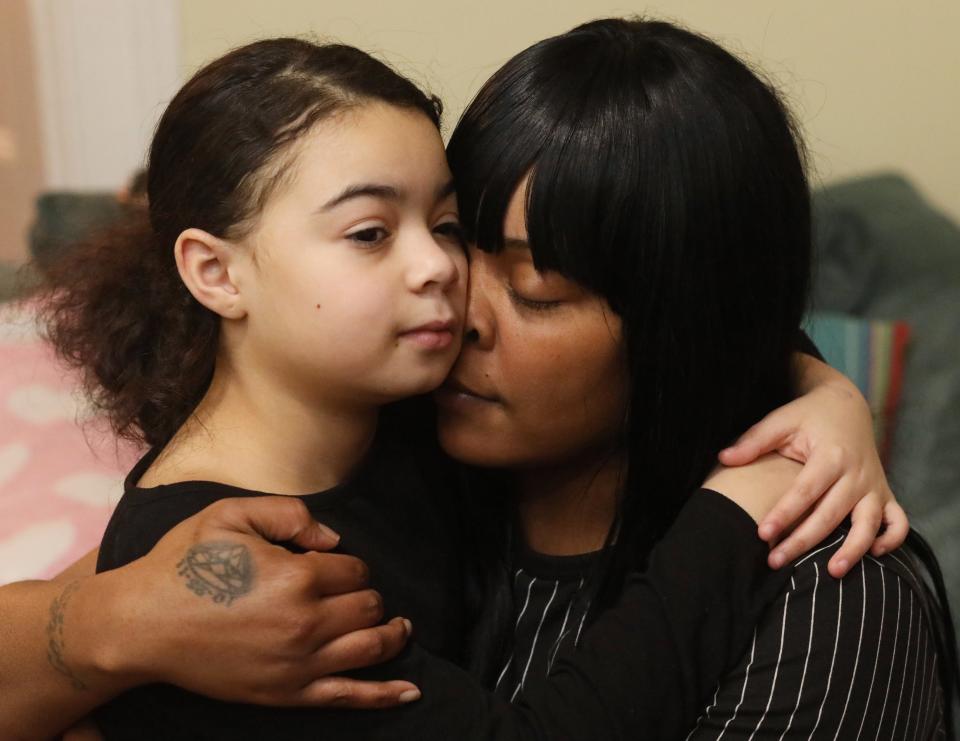
What will this school year look like in New York?
At the close of a school year like no other, families across New York expressed hope, ranging from the cautious to the exuberant, as they looked forward to the next school year and beyond.
This year, there will be new milestones and graduations, hopefully, a "normal" one 16-year-old Say Kler Paw would like her entire family of 11 to attend in Utica. Four of the seven children in their family of Karen refugees from Myanmar will have graduation or moving-up ceremonies this year: from high school, from college and into middle school.
Davita Bateman has her son CJ's graduation on her mind, too. No matter what else happens, that's one part of the future she's determined to see in person.
In the community garden where she tends a raised bed, Bateman tugs weeds from around the garlic beginning to sprout. Her family will spend the next school year in a new, larger home she's found across town, with more space to live and grow.
An orange flower-shaped pinwheel spins in the breeze and Bateman keeps digging into the soil, pulling out the shrubs and the weeds that have entangled this past year, joining other families looking forward to the future.
Contributing: Peter D. Kramer, Kristen Cox Roby, Katelyn Cordero, Tiffany Cusaac-Smith, Amy Roth, Adria Walker
This article originally appeared on USA TODAY: COVID back-to-school: How families survived pandemic online learning

